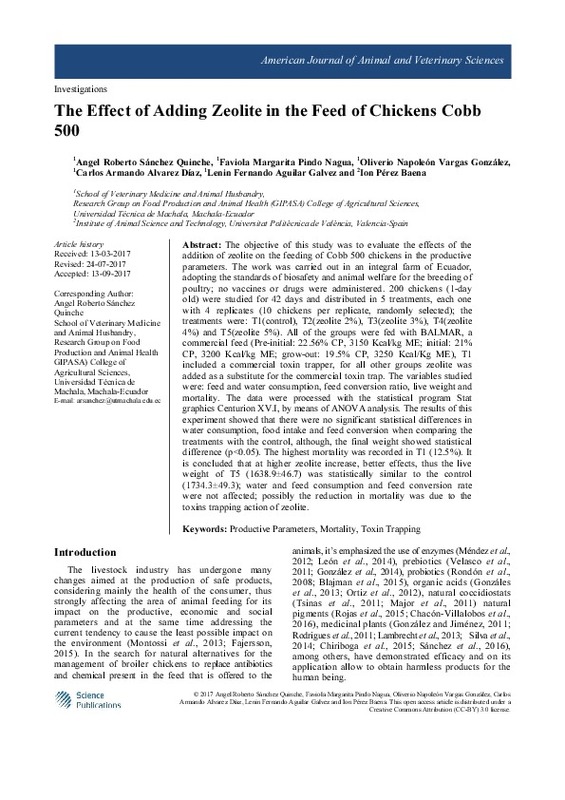JavaScript is disabled for your browser. Some features of this site may not work without it.
Buscar en RiuNet
Listar
Mi cuenta
Estadísticas
Ayuda RiuNet
Admin. UPV
The Effect of Adding Zeolite in the Feed of Chickens Cobb 500
Mostrar el registro sencillo del ítem
Ficheros en el ítem
| dc.contributor.author | Sanchez-Quinche, Angel Roberto
|
es_ES |
| dc.contributor.author | Pindo Nagua, Faviola Margarita
|
es_ES |
| dc.contributor.author | Vargas González, Oliverio Napoleón
|
es_ES |
| dc.contributor.author | Alvarez Díaz, Carlos Armando
|
es_ES |
| dc.contributor.author | Aguilar Galvez, Lenin Fernando
|
es_ES |
| dc.contributor.author | Pérez Baena, Ion
|
es_ES |
| dc.date.accessioned | 2018-06-01T04:26:55Z | |
| dc.date.available | 2018-06-01T04:26:55Z | |
| dc.date.issued | 2017 | es_ES |
| dc.identifier.issn | 1557-4555 | es_ES |
| dc.identifier.uri | http://hdl.handle.net/10251/103147 | |
| dc.description.abstract | [EN] The objective of this study was to evaluate the effects of the addition of zeolite on the feeding of Cobb 500 chickens in the productive parameters. The work was carried out in an integral farm of Ecuador, adopting the standards of biosafety and animal welfare for the breeding of poultry; no vaccines or drugs were administered. 200 chickens (1-day old) were studied for 42 days and distributed in 5 treatments, each one with 4 replicates (10 chickens per replicate, randomly selected); the treatments were: T1(control), T2(zeolite 2%), T3(zeolite 3%), T4(zeolite 4%) and T5(zeolite 5%). All of the groups were fed with BALMAR, a commercial feed (Pre-initial: 22.56% CP, 3150 Kcal/kg ME; initial: 21% CP, 3200 Kcal/kg ME; grow-out: 19.5% CP, 3250 Kcal/Kg ME), T1 included a commercial toxin trapper, for all other groups zeolite was added as a substitute for the commercial toxin trap. The variables studied were: feed and water consumption, feed conversion ratio, live weight and mortality. The data were processed with the statistical program Stat graphics Centurion XV.I, by means of ANOVA analysis. The results of this experiment showed that there were no significant statistical differences in water consumption, food intake and feed conversion when comparing the treatments with the control, although, the final weight showed statistical difference (p<0.05). The highest mortality was recorded in T1 (12.5%). It is concluded that at higher zeolite increase, better effects, thus the live weight of T5 (1638.9±46.7) was statistically similar to the control (1734.3±49.3); water and feed consumption and feed conversion rate were not affected; possibly the reduction in mortality was due to the toxins trapping action of zeolite | es_ES |
| dc.language | Inglés | es_ES |
| dc.publisher | Science Publications | es_ES |
| dc.relation.ispartof | American Journal of Animal and Veterinary Sciences | es_ES |
| dc.rights | Reconocimiento (by) | es_ES |
| dc.subject | Productive Parameters | es_ES |
| dc.subject | Mortality | es_ES |
| dc.subject | Toxin Trapping | es_ES |
| dc.title | The Effect of Adding Zeolite in the Feed of Chickens Cobb 500 | es_ES |
| dc.type | Artículo | es_ES |
| dc.identifier.doi | 10.3844/ajavsp.2017.182.187 | es_ES |
| dc.rights.accessRights | Abierto | es_ES |
| dc.description.bibliographicCitation | Sanchez-Quinche, AR.; Pindo Nagua, FM.; Vargas González, ON.; Alvarez Díaz, CA.; Aguilar Galvez, LF.; Pérez Baena, I. (2017). The Effect of Adding Zeolite in the Feed of Chickens Cobb 500. American Journal of Animal and Veterinary Sciences. 12(3):182-187. doi:10.3844/ajavsp.2017.182.187 | es_ES |
| dc.description.accrualMethod | S | es_ES |
| dc.relation.publisherversion | http://dx.doi.org/10.3844/ajavsp.2017.182.187 | es_ES |
| dc.description.upvformatpinicio | 182 | es_ES |
| dc.description.upvformatpfin | 187 | es_ES |
| dc.type.version | info:eu-repo/semantics/publishedVersion | es_ES |
| dc.description.volume | 12 | es_ES |
| dc.description.issue | 3 | es_ES |
| dc.relation.pasarela | S\359338 | es_ES |








